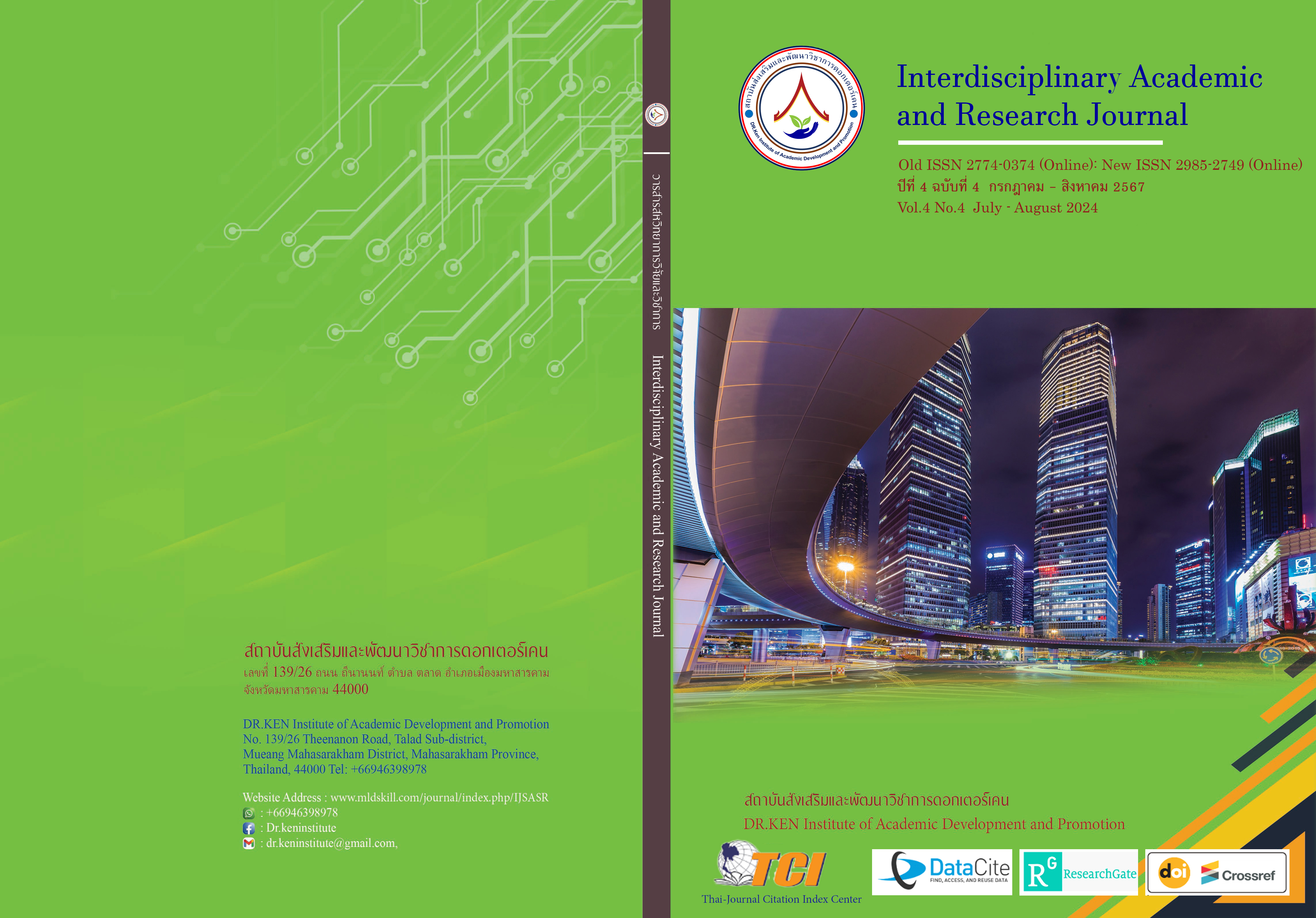The Guidelines Management of the Affect the Learning Organization Mahachulalongkornajavidyalaya University Nakhon Ratchasirma Campus
DOI:
https://doi.org/10.60027/iarj.2024.277267Keywords:
Guidelines ; , Management; , Learning OrganizationAbstract
Background and Aims: A learning organization is a concept for developing learning conditions of leadership and collaborative learning of people in the organization. That causes the transfer of knowledge, experiences, and skills together and continuous organizational development. The purpose of this research was to study the administrative operating conditions that affect the learning organization of Mahachulalongkornrajavidyalaya University Nakhon Ratchasima Campus, 2) the guidelines management affect the learning organization of Mahachulalongkornrajavidyalaya University Nakhon Ratchasima Campus
Methodology: The sampling group of administrators, lecturers, and staff used included 66 participants of key performance (the sample size taken from Krejcie & Morgan table (1970) concept at 95%) of Mahachulalongkornrajavidyalaya University Nakhon Ratchasima Campus. The instrument used in data collection was a questionnaire Likert rating scale questionnaire with an IOC value of 0.60 - 1.00 and a reliability value of 0.95. Statistics implemented in data analysis were frequency, percentage, mean, and standard deviation.
Results: 1. Study the administrative operating conditions that affect the learning organization of Mahachulalongkornrajavidyalaya University Nakhon Ratchasima Campus found that (1) the administrative level of Mahachulalongkornrajavidyalaya University Nakhon Ratchasima Campus overall was at high level, (2) Learning organization level of Mahachulalongkornrajavidyalaya University Nakhon Ratchasima Campus Overall was at high level.
- Management guidelines that affect the learning organization of Mahachulalongkornrajavidyalaya University Nakhon Ratchasima Campus. It can be concluded that (1) The vision of the administration must be carried out according to policies that support various activities that enable personnel to learn regularly. (2) Creating knowledge and understanding about learning organizations, which provides opportunities for knowledge transfer, including exchanging knowledge and experiences to develop knowledge and ability to change attitudes to become effective personnel. and learning together regularly. (3) Linking to the world of learning that promotes the use of innovation and modern technology that can help create learning to work successfully and achieve the set objectives. (4) Building morale and encouragement, organizing work systems, and assigning work according to the abilities of personnel, with praise, praise, and goodwill towards one another, and (5) Forecasting the future of the organization using knowledge, experience, and skills, as well as both past and present databases, continuously linked together.
Conclusion: Administrative guidelines affecting the learning organization of Mahachulalongkornrajavidyalaya University Nakhon Ratchasima Campus. Executives will have policies and goals for developing activities that enable personnel to learn regularly providing opportunities for knowledge transfer, including the exchange of knowledge and experiences. There was an appropriate selection of innovation and information technology to manage learning to create a learning atmosphere, building morale, and assigning work according to the abilities of personnel is praised. Including future predictions of the organization that uses knowledge and experience as a continuously linked database.
References
กนกเนตร คำไพ. (2566). ปัจจัยทางการบริหารที่ส่งผลต่อการเป็นองค์กรแห่งการเรียนรู้ของโรงเรียนในสังกัดสำนักงานเขตพื้นที่การศึกษาประถมศึกษา สกลนคร เขต 1. ครุศาสตรมหาบัณฑิต (การบริหารการศึกษา) มหาวิทยาลัยราชภัฏสกลนคร.
กฤษณะ ดาราเรือง. (2558). ตัวแบบองค์การแห่งการเรียนรู้และการจัดการความรู้สู่การเป็นองค์การแห่งการเรียนรู้. วารสารวิชาการ, 21 (2), 133- 145.
จินตนา ดีดวงพันธ์. (2565). ภาวะผู้นำเชิงสร้างสรรค์ของผู้บริหารสถานศึกษาที่ส่งผลต่อการเป็นองค์กรแห่งการเรียนรู้ของสถานศึกษา สังกัดสำนักงานเขตพื้นที่การศึกษามัธยมศึกษามุกดาหาร. ครุศาสตรมหาบัณฑิต(สาขาวิชาการบริหารและพัฒนาการศึกษา) มหาวิทยาลัยราชภัฏสกลนคร.
ชานันท์ ขำขันมะลี และ จำเนียร พลหาญ. (2565). แนวทางการพัฒนาองค์การแห่งการเรียนรู้ของสถานศึกษาสังกัดสำนักงานเขตพื้นที่การศึกษาประถมศึกษา ร้อยเอ็ด เขต 1. วารสารสหวิทยาการวิจัยและวิชาการ, 2 (6), 17-34.
ธันยาภรณ์ เสาร์เกิด. (2560). แนวทางการเสริมสร้างการเป็นองค์กรแห่งการเรียนรู้ของพนักงานสายบริการ กรณีศึกษา มหาวิทยาลัยพะเยา. รัฐประศาสนศาสตรมหาบัณฑิต (สาขาวิชานโยบายสาธารณะ) มหาวิทยาลัยพะเยา
บุญชม ศรีสะอาด. (2556). หลักการวิจัยเบื้องต้น. พิมพ์ครั้งที่9. กรุงเทพฯ : สุวิริยาสาส์น.
พนิดา มากสมบัติ, สุรัตน์ ไชยชมภู และ พงศ์เทพ จิระโร. (2560). การจัดการความรู้สู่องค์กรแห่งการเรียนรู้ สำนักคอมพิวเตอร์มหาวิทยาลัยบูรพา. วารสารบัณฑิตวิทยาลัย มหาวิทยาลัยราชภัฏราชนครินทร์, 1(2), 27-34.
ภูมิภัทร กลางโคตร์. (2560). กลยุทธ์การบริหารโรงเรียนเพื่อเป็นองค์กรแห่งการเรียนรู้แบบมืออาชีพสำหรับโรงเรียนมัธยมศึกษา สังกัดสำนักงานเขตพื้นที่การศึกษามัธยมศึกษาภาคตะวันออกเฉียงเหนือ. ปรัชญาดุษฎีบัณฑิต (การบริหารและพัฒนาการศึกษา) มหาวิทยาลัยราชภัฏสกลนคร.
รัฐจักรพล สามทองก่ำ, ทนง ทองภูเบศร์ และวีระวัฒน์ พัฒนกุลชัย. (2566). การพัฒนาสถาบันอุดมศึกษาสู่องค์การแห่งการเรียนรู้ในความปรกติใหม่. วารสารสถาบันวิจัยและพัฒนา มหาวิทยาลัยราชภัฏบ้านสมเด็จเจ้าพระยา, 8(1), 90-99.
วันชนก อาจปรุ. (2564). แนวทางการพัฒนาความเป็นองค์กรแห่งการเรียนรู้ของสถานศึกษา สังกัดสำนักงานส่งเสริมการศึกษานอกระบบและการศึกษาตามอัธยาศัยในเขตภาคกลาง. ศึกษาศาสตรมหาบัณฑิต (การบริหารการศึกษา) มหาวิทยาลัยเทคโนโลยีราชมงคลธัญบุรี
วิโรจน์ สารรัตนะ. (2555). แนวคิด ทฤษฎีและประเด็นเพื่อการบริหารทางการศึกษา. (พิมพ์ครั้งที่ 8). กรุงเทพฯ. ทิพย์วิสุทธิ์.
สมชาย รัตนคช. (2559). การพัฒนาองค์การแห่งการเรียนรู้ของสถาบันอุดมศึกษา. วารสารวิทยบริการ มหาวิทยาลัยสงขลานครินทร์, 27(1), 144-150
สายบัว ชัชวาล สุวรรณา โชติสุกานต์ และอรสา โกศลานันทกุล. (2554). ศึกษาการเป็นองค์กรแห่งการเรียนรู้ของสถานศึกษาสังกัดสำนักงานเขตพื้นที่การศึกษาปราจีนบุรี. วารสารบัณฑิตศึกษา มหาวิทยาลัยราชภัฏวไลยอลงกรณ์ในพระบรมราชูปถัมภ์, 5(1), 25-33.
สุธรรม สิกขาจารย์, ทัศนีย์ ช่อเทียนทิพย์,วิรัตน์ มณีพฤกษ์ และ นําพล ม่วงอวยพร. (2562). การทบทวนแนวคิดเกี่ยวกับสถานศึกษาในฐานะเป็นองค์การแห่งการเรียนรู้. วารสารวิชาการ การจัดการภาครัฐและเอกชน, 1(1), 26-38.
อุบลรัตน์ ศรีวิเชียรอำไพ. (2565). รูปแบบการพัฒนาองค์กรแห่งการเรียนรู้ของสถาบันอุดมศึกษาเอกชน ในภาคใต้ของประเทศไทย. ศึกษาศาสตรดุษฎีบัณฑิต (การบริหารการศึกษา): มหาวิทยาลัยหาดใหญ่
Apiani, N., Retnowati, R., & Sunaryo, W. (2023). The Relationship of Transformational and Learning Organization with Teacher Creativity. Scaffolding: Jurnal Pendidikan Islam dan Multikulturalisme, 5(2), 982-1000.
Halmaghi, E.E., & Todarita, T.E. (2023). Creating a Learning Culture in the Organization. Scientific Bulletin, 2(56), 210-214.
Krejcie, R.V., & Morgan, D.W. (1970) . Determining Sample Size for Research Activities. Educational and Psychological Measurement, 30 (3), 607-610.
Kullan, S., Mansor, M., & Ishak, R. (2022). The validity and reliability of an instrument to evaluate the practices of learning organization. International Journal of Evaluation and Research in Education (IJERE), 11(4), 1725-1733.
Downloads
Published
How to Cite
Issue
Section
License
Copyright (c) 2024 Interdisciplinary Academic and Research Journal

This work is licensed under a Creative Commons Attribution-NonCommercial-NoDerivatives 4.0 International License.
Copyright on any article in the Interdisciplinary Academic and Research Journal is retained by the author(s) under the under the Creative Commons Attribution-NonCommercial-NoDerivatives 4.0 International License. Permission to use text, content, images, etc. of publication. Any user to read, download, copy, distribute, print, search, or link to the full texts of articles, crawl them for indexing, pass them as data to software, or use them for any other lawful purpose. But do not use it for commercial use or with the intent to benefit any business.
















.png)


